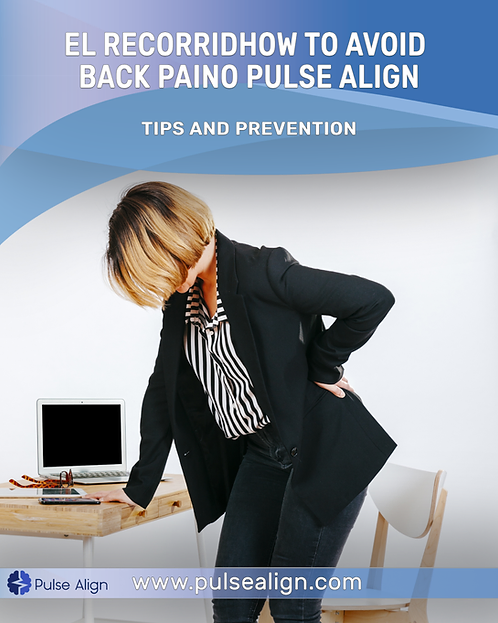Back pain is a significant issue. It affects approximately 20% of people worldwide. The first episode of low back pain typically occurs between the ages of 30 and 50. It can range from mild discomfort to debilitating agony, and it often hinders our ability to perform daily tasks. While there are various treatment options available, it’s crucial to focus on prevention and addressing the root causes of back pain. In this comprehensive guide, we’ll explore how to avoid back pain and discuss the potential benefits of a holistic approach, such as Pulse Align, that aims to restore normal function rather than merely alleviating symptoms.
Understanding Back Pain
Before we dive into prevention strategies, it’s essential to understand what causes back pain. The human back is a complex structure consisting of bones, muscles, ligaments, and joints that work together to support the body. Back pain can result from various factors, including:
1. Poor Posture
One of the leading causes of back pain is poor posture. Sitting or standing with improper alignment can strain the back muscles, leading to discomfort or pain. Find some key exercises for a healthy back and better posture
2. Muscle Strain
Overexertion or lifting heavy objects can cause muscle strain in the back, resulting in acute or chronic pain.
3. Spinal Issues
Issues like herniated discs, spinal stenosis, or scoliosis can lead to chronic back pain. These conditions often require medical attention.
4. Sedentary Lifestyle
Sitting for prolonged periods without proper breaks and exercise can weaken the muscles and lead to back pain.
5. Stress and Mental Health
Stress and mental health issues can manifest physically, often leading to muscle tension and back pain.
Prevention Strategies
Now, let’s delve into practical strategies to avoid back pain and maintain a healthy, pain-free back.
1. Maintain Proper Posture
Maintaining good posture is crucial for back health. Ensure that your spine is aligned when sitting and standing. Ergonomic chairs, standing desks, and posture-correcting exercises can help.
2. Stay Active
Regular exercise strengthens your back muscles and improves flexibility. Focus on exercises that target the core and lower back to provide stability.
3. Lift Correctly
When lifting heavy objects, bend at your knees, not your waist. Keep the object close to your body, and avoid twisting while lifting.
4. Take Breaks
If you have a sedentary job, take short breaks to stand, stretch, and walk around. This can prevent muscle stiffness and back pain.
5. Manage Stress
Stress can manifest in physical ways, including back pain. Practice stress-reduction techniques such as meditation, deep breathing, or yoga.
6. Ergonomic Workspace
Ensure your workspace is ergonomically designed to reduce the strain on your back. This includes a proper chair, desk, and computer setup.
7. Maintain a Healthy Weight
Excess weight puts additional stress on the back. Maintain a healthy weight through a balanced diet and regular exercise.
8. Stay Hydrated
Proper hydration is essential for the health of your spinal discs, which act as shock absorbers for your spine. Also, stay at such a temperature that is suitable for back pain.
The Role of Pulse Align
Addressing the root causes of back pain is essential for long-term relief. Pulse Align is a holistic approach that focuses on restoring normal function and well-being. Instead of simply masking the symptoms, Pulse Align aims to identify and address the underlying issues contributing to back pain. Here are some potential benefits of Pulse Align:
1. Targeted Treatment
Pulse Align uses advanced diagnostics to identify the specific issues in your back, allowing for a personalized treatment plan.
2. Natural Healing
The approach emphasizes the body’s natural ability to heal itself. By addressing the root causes, it promotes a natural return to normal function.
3. Non-Invasive
Pulse Align is a non-invasive treatment, making it a safe and gentle option for those seeking back pain relief without surgery or medication.
4. Long-Term Results
By focusing on the root causes, Pulse Align aims to provide long-term relief, reducing the risk of recurring back pain.
5. Holistic Approach
Pulse Align takes into account not only the physical aspects but also the mental and emotional well-being of the patient, providing a comprehensive approach to healing.
Statistics and Studies
To reinforce the importance of addressing the root causes of back pain, it’s essential to reference statistics and studies that support this approach.
According to a study published back pain is a worldwide concern and emphasizes its high prevalence. For example, up to 23% of adults suffer from chronic low back pain. Highlight the economic impact of back pain by citing the estimated annual spending of $200 billion on back pain management. This figure underscores the financial burden on healthcare systems and individuals. Additionally, the prevalence of back pain in children (e.g., 1% for 12-year-olds and 5% for 15-year-olds) and the cumulative incidence, indicate that it can affect a significant portion of young individuals.
In another study conducted by the National Institute of Neurological Disorders and Stroke, it was found that chronic back pain is often the result of a combination of physical and psychological factors. This underscores the importance of addressing both the physical and emotional aspects of back pain to achieve lasting relief.
Conclusion
In conclusion, preventing back pain is crucial for a healthy and pain-free life. Instead of merely treating the symptoms, focusing on addressing the root causes is the key to long-term relief. Pulse Align offers a holistic approach that promotes natural healing and a return to normal function. By targeting the specific issues that lead to back pain, it provides personalized and effective treatment.
We invite you to consider lifestyle changes to maintain a healthy back and explore the potential benefits of Pulse Align. Remember, back pain doesn’t have to be a constant companion in your life. By taking a proactive approach and addressing the root causes, you can enjoy improved well-being and a natural return to normal function.
References:
Casiano, V.E., Sarwan, G., Dydyk, A.M., Varacallo, M. (February 20, 2023). “Back Pain.” https://www.ncbi.nlm.nih.gov/books/NBK538173/ National Institutes of Health (NIH). “Back Pain.” Last reviewed on March 08, 2023. https://www.ninds.nih.gov/health-information/disorders/back-pain
As the visionary CEO of Pulse Align, François is dedicated to transforming the landscape of pain management and posture health. With a deep-rooted passion for innovation and a commitment to excellence, François leads the team in developing cutting-edge solutions that empower individuals to live healthier, pain-free lives. Under his leadership, Pulse Align has become a beacon of hope and support for those navigating postural-related issues and chronic pain. François brings a wealth of experience in neuromodulation and patient management technologies, combining strategic insight with a compassionate approach to address the unique challenges faced by each individual.




